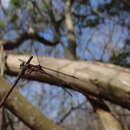Comprehensive Description
provided by North American Flora
Chloroleucon mangense (Jacq.) Britton & Rose
Mimosa mangensis Jacq. Enum. 34. 1760.
Mimosa parvifolia Sw. Fl. Ind. Occ. 984. 1800.
Mimosa antillarum Lam.; Poir. in Lam. Encyel. Suppl. 1; 80. 1810.
Acacia parvifolia Willd. Sp. PI. 4: 1086. 1806.
Acacia micrantha'Dcsv.; Hamilt. Prodr. 60. 1825.
Inga marlhae Spreng.; DC. Prodr. 2; 441. 1825.
Pithecolobium parvifolium Benth. Lend. Journ. Bot. 3: 223. 1844.
Feuilleea mangensis Kuntze, Rev. Gen. PI. 186. 1891.
Enterolobium mangense Fawcett & Rendle, Fl. Jam. 4: 151. 1920.
A small tree, 5-8 m. high, the foliage and inflorescence pubescent or glabrate. Stipular spines 5-15 mm. long, or wanting on many branches; petioles very slender, usually bearing a small sessile gland; pinnae 5-10 pairs, often bearing a gland between one or more of the pairs; leaflets 8-30 pairs, linear or linear-oblong, 4—7 mm. long, acutish or obtuse, rather prominently veined beneath; peduncles 1-2 cm. long; calyx 2-3.5 mm. long; corolla 4—5 mm. long; legume linear, compressed or nearly flat, glabrous, reticulate-veined, curved or nearly straight, 6-14 cm. long, 10-12 mm. wide, very tardily dehiscent.
Type locality: Mango Island, Cartagena, Colombia. Distribution: Jamaica; Panama to Colombia and Brazil.
- bibliographic citation
- Nathaniel Lord Britton and Joseph Nelson Rose. 1928. (ROSALES); MIMOSACEAE. North American flora. vol 23(1). New York Botanical Garden, New York, NY

